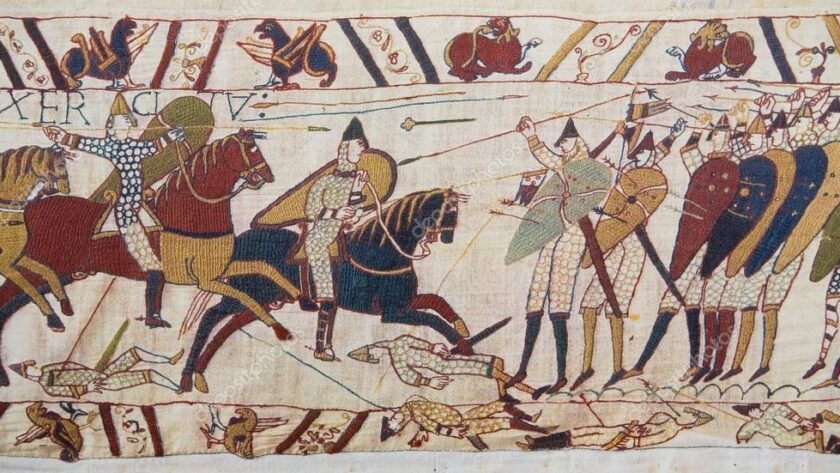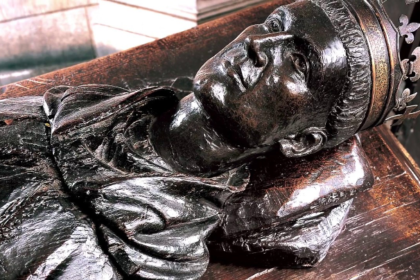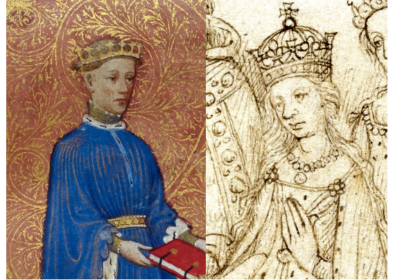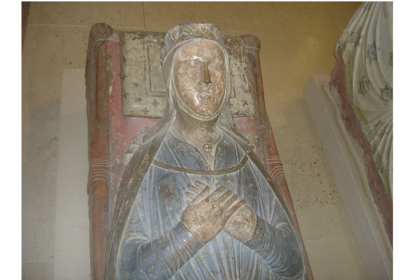The Bayeux Tapestry, though actually a piece of embroidery and not a tapestry at all, is today considered to be one of the most significant artefacts of medieval history. Documenting the lead up to the events of the Norman Conquest of England from around 1064, culminating in the 1066 Battle of Hastings itself, Bayeux Tapestry is remarkable for the events it describes, the fact of its creation, and as an incredible piece of artistry in and of itself.
However, it wasn’t always held in such high historical regard. In fact, throughout all the Middle Ages, we only have a single definite reference to it. The 1476 inventory of Bayeux Cathedral has an undistinguished entry:
‘Item une tente tres longue et estroicte de telle a broderie d’ymages et escripteaulx, faisans representation du Conquest d’Angleterre, laquelle est tendu environ la nefde l’église le jour et par l’octave des reliques.’
(Item: a very long and narrow linen of such embroidery of images and inscriptions, representing the Conquest of England, which is stretched around the nave of the church on the day and through the octaves of the relics.)

‘The day and through the octaves of the relics’ refers to the Feast Day of the Holy Relics and the succeeding 8 days; i.e. from the 1st to the 8th of July.
The rest of the year it is believed that the canons of Bayeux Cathedral kept it safe in a chest. We can only speculate why it was brought out on this date; perhaps it fulfilled the criteria for a holy relic because St. Edward the Confessor is depicted on it.
This humble record is all we can say for certain was known of the Bayeux Tapestry during the Middle Ages; we do not even have records of how, when, or where it was made (though historians infer from its style and characteristics that it was made in England by women around 1070). The next reference to it wasn’t until 1724.
There is one other medieval reference which historian George T. Beech believes is in relation to the Bayeux Tapestry, in the 1430 inventory of Duke Philip the Good of Burgundy. It reads:
‘Ung grant tapiz de haulte lice, sans or, de l ‘istoire du duc Guillaume de Normandie, comment il conquist l ‘Engleterre.’
(A large high warp tapestry, without gold thread, of the history of Duke William of Normandy, how he conquered England.)
If this entry does refer to the Bayeux Tapestry as Beech believes, it changes everything we know about the Tapestry, as it was previously believed have been housed in Bayeux Cathedral since its creation; whereas, this entry suggests it was held in Burgundy at some point around 1430, and perhaps donated to Bayeux Cathedral some time before 1476.
This theory has not found widespread acceptance, and the inventory entry could refer to a separate tapestry depicting the Norman Conquest. In fact a study by Christopher Norton suggests that the Bayeux Tapestry was designed specifically to be displayed around the 11th century nave of Bayeux Cathedral.
Regardless, the fact remains that the now-famous Bayeux Tapestry made its way through the Middle Ages in complete obscurity, unremarked upon except for one, possibly two inventory records, valued only by the canons of Bayeux Cathedral.
The Bayeux Tapestry can be explored in full through the Bayeux Museum website: https://www.bayeuxmuseum.com/…/discover…/explore-online/






[…] THE BAYEUX TAPESTRY THROUGH THE MIDDLE AGES […]